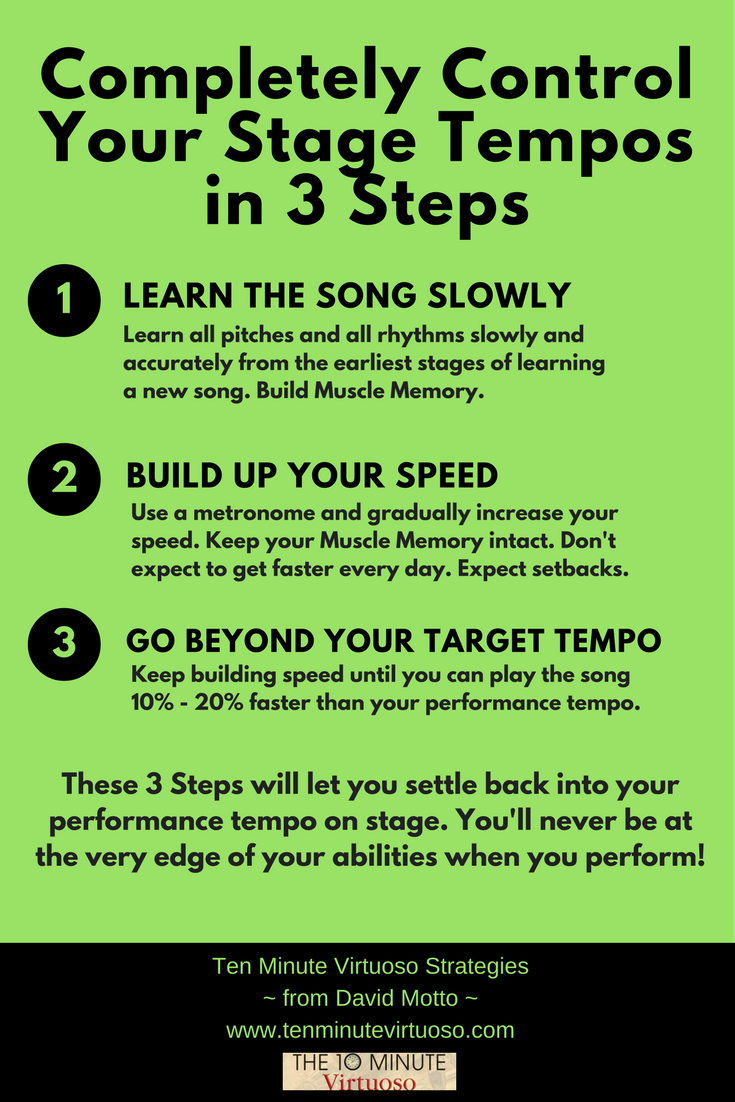David Motto’s Practice Tip of the Week:
The Proven Way to Control Performance Tempos
Hitting Your Target Tempo for the First Time
For every song that you learn, you’ll have a performance tempo in mind. This tempo becomes a goal–a target that you want to hit consistently on stage.
The best way to work up to this tempo is to play the music accurately from the earliest stages of learning a new song. This means starting the learning process by playing VERY slowly and building muscle memory that will still be with you in the future when you need it.
After hours, days, weeks, or even months of practicing, you will finally hit your target. That day will feel like a major achievement, and you will have earned the right to congratulate and reward yourself for meeting your goal. (Really, it’s a big deal. Allow yourself to celebrate!)
Staying in Control of Your Target Tempo – Anywhere
At that point, however, you will need to create a new goal. Your new goal will be to consistently control the music at your target tempo under any circumstances.
Because, well, let’s be real: The the stage feels different than your practice room!
It’s one thing to work up to this tempo in your practice room. But, it’s quite another to have the poise and focus needed to play expressively at this tempo during a performance.
To stay in control during performances, you need a strategy in the practice room. This practice method must guarantee that you can successfully play at your target tempo while onstage.
The Proven Strategy for Maintaining Control on Stage
Here’s the proven strategy for staying in control of your tempos in performance:
Make sure you can play all of your music 10% to 20% faster than your performance tempo.
This method is sometimes called “over practicing,” and it yields amazing results. The type of results that many musicians can only dream of.
Here are a couple examples:
Example 1: If your performance tempo is 100 beats per minute (bpm), then work your technique to the level where you can play the song at 110 – 120 bpm.
Example 2: If your performance tempo is 160bpm, work up to 176 – 192 bpm. In this case, maybe 180 bpm is a good target in the practice room.
No matter what your target tempo for the stage, going beyond this tempo in the practice room means that you will never be at the very edge of your abilities in performance. Having to be at the very top, 100% or your capabilities on stage is nerve-wracking. I highly recommend that you give yourself a little “headroom” so you can settle back into your performance tempo from the more difficult tempos you’ve practiced.
It’s More than Control – It’s Confidence Too!
Using this practice tip, you’ll have the control and the confidence you need to succeed on stage. You’ll be able to handle the slightly faster concert tempos that sometimes occur when the adrenaline is flowing.
Knowing that your practice room training was more rigorous than the performance itself, you can approach the stage feeling confident, inspired, and ready to play.
The stage environment will seem seem downright comfortable – maybe even fun! If you’re like most musicians this will be an unusual – but welcome – feeling.
To Your Musical Success!
–David Motto




